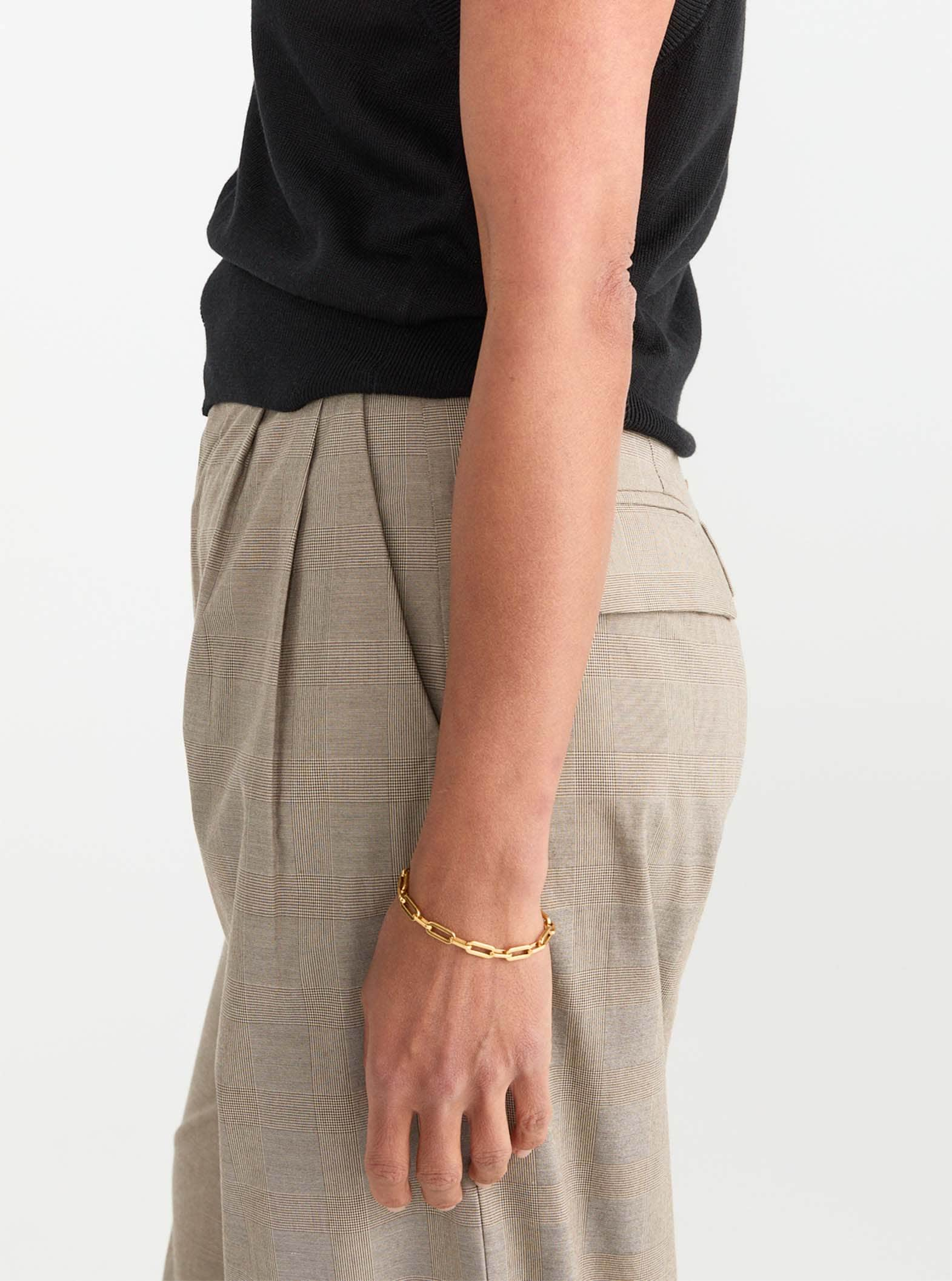-
-
-
-
-
-
-
-
-
Currency
cover-stories
Bridget Gao Hollitt Is Giving Herself The Grace To Change


The model, actress and singer-songwriter is not who she once was. Motivated by a pursuit of authenticity, Gao Hollitt has released her first record, and, in the process, redefined her relationship with creativity, herself and the world around her.
The model, actress and singer-songwriter is not who she once was. Motivated by a pursuit of authenticity, Gao Hollitt has released her first record, and, in the process, redefined her relationship with creativity, herself and the world around her.
If Bridget Gao Hollitt is a cyborg, she’s not like one you’ve likely ever encountered in science fiction before. “I just like the idea of being a cyborg, but it’s like, I’m not a cool cyborg,” she explains, laughing. We’re speaking over Zoom, she from a sun-drenched Paddington cafe’s courtyard. The murmur of conversations happening around her invites the entertaining prospect that her playful analogy is being overheard. “It’s not like Ex Machina, it’s like Blade Runner. If Blade Runner was…no, it’s not even cool like Blade Runner. It’s like this nerdy little robot that’s like,half-made of skin,” she continues, eliciting laughter. “That sounds really creepy, but it’s like a fleshy and awkward and lame robot that doesn’t fit in.”
Contrary to appearances, Gao Hollitt is not responding to a strange hypothetical of my devising. The Chinese-Australian model and actress — who has just added recording artist to her long list of creative endeavours with the release of her debut EP, how was that for you — is explaining the origins of the record’s final track, ‘Algorithm Defined Fantasy Girl’.
"I wrote it because talking about being a cyborg was a way for me to express feeling strange and disconnected from reality; whilst at the same time, fiercely in contact with every sensation, feeling and sound."
She describes the inhabiting of a mind that doctors would consider that step or two further away from what is considered average; whether creativity or neurodivergence, she intends to honour it.
"[Feeling different] is a big part of the way that I write and why I write the way I do, because it’s an attempt at reclaiming that, and making it beautiful and valuable and something that I’m proud of, rather than something that I’m ashamed of."
Gao Hollitt’s creativity had manifested in other ways, long before the release of how was that for you, but there were professional experiences she had to go through first, to get to this state of authenticity and purpose that she now inhabits. Beginning her career as a model in New York while studying acting, she describes a loss of autonomy during those early years; of not yet knowing her own creative tastes, and giving herself over to the tastes of those around her (“I realised by doing that, I was completely removing my own autonomy in the process and disconnecting myself from finding out who I really am, and letting that be dictated by the industry.”) So she established a framework for the brands with whom she would work, ones that shared her deeply-held value of sustainability, including B-corp certified brands Bassike and Maggie Marilyn and climate-positive Esse Studios. In addition to continuing to model, Gao Hollitt has since broken into the craft for which she first studied. Last year she secured one of her first on-screen credits in ‘Super Pumped: The Battle for Uber’, a dramatisation of the ridesharing company opposite Joseph Gordon-Levitt, as his character’s long-suffering girlfriend, Gabi, a passionate violinist.
Photographed By: Michael Comninus
"I’m really interested in lots of different things, and I think that, for me, changing and switching mediums keeps vitality alive, and it keeps my love for each medium alive, because I get to have a break."
Rather than drain, it is obvious that the multifaceted creative expression sustains her. “It never becomes rules-based or oppressive and it’s always just for the love, and I think that’s really important as well.” Though she’d been writing for years, it was only until hearing The Incompatible Okay Kaya — a nine-track album of acoustic covers, mostly of Okay Kaya’s own previously released songs — that she decided she’d channel that curiosity and creativity and love into a record, decidedly her most self-revealing work yet.
“When I heard [Okay Kaya’s acoustic covers of her own songs], I was like, ‘oh, this is how these songs are always meant to sound’. And this is a full assumption — I don’t know anything about the process — but to me it felt like she made those songs, she got them produced, she was kind of like, ‘yeah, I guess’. And then was like, ‘oh no…this is how I wrote them. I just wanna release them naked and bare’, and they're so much more impactful.” There is such a temptation for artists to release upbeat songs that they believe people will like, Gao Hollitt observes, or a pressure from labels to record dance tracks that they believe will get more plays. “And then later on in life or later on in their career, they go, ‘okay, I'm actually going to release them the way that I always wanted them to be’. So I was like, the challenge to myself is to do that first.”
She pauses briefly to quickly thank a waiter who has just laid something on her table, before continuing. “I kind of made a little handshake agreement with myself because I can be quite an assimilate person — I risk becoming quite conformist if left unchecked — and the way that I avoid that is by running in the other direction.” Notably, how was that for you is published under her mother’s family name, Gao, as a way of honouring her mother — her most influential creative force and “a warrior of the highest order” — and reclaiming her ties to her Chinese heritage.
"I think if you can do that first,” she continues, “you’ve given yourself permission to be authentic and that will stay with you forever; whereas trying to give yourself permission to be authentic later in the journey is really hard."
In addition to Okay Kaya, Gao Hollitt attributes the Japanese philosophy of wabi-sabi as one of how was that for you’s biggest influences (“Making things where the imperfections are what makes it beautiful.”) Listening to the five-track EP, one feels they are listening to a stream-of-consciousness voice note, or disclosure between friends. The truth is not far from that. The entire project was recorded between Gao Hollitt’s living room and producer Johannes Burger’s bedroom, recording gear assembled into a makeshift studio, and a “crappy, old drum kit” from the garage pulled into these intimate spaces.

Photographed By: Michael Comninus
“The intimacy [of the production] comes from intent, but also the deep, deep trust and safety that I felt in that environment with him, and the fact that it was recorded in our homes. I was sitting on his bed,” she says, laughing. “His room is that small, and there was nowhere else to fit. You can hear birds in the background, because we recorded in my house and there was no soundproofing. So we were very open to the environments that we were in whilst maintaining as clean a sound as possible.”
Giving herself the grace to change as she grows in awareness of what feels authentic to her journey — in career, in creativity, in life — means that some choices that once resonated no longer apply. “For me, I think what I’m learning is flexibility and being realistic, and what that looks like,” she says. Out of necessity, Gao Hollitt no longer models solely for sustainable brands, though she still prioritises those with eco-conscious practices or products with longer life cycles wherever she can. “I will often, in my life, pendulum swing until I find the happy medium.” It is a decision that she has sat with and wondered if she has conceded her values somehow, but ultimately has given herself the empathy to make.
"I think the energy of saying ‘no’ [to work] and then wondering how I’m going to find money and all of that, is better used elsewhere. So that’s definitely changed, but in terms of my connection to the earth and the systems that are in place that need to be changed? I feel equally as passionate about it, but I have a little bit less of a god complex about it, which was necessary. I think I needed to get over myself a little bit,” she continues, laughing. “It was going to exhaust me if I thought I was going to save the world and I was just failing.”
Photographed By: Michael Comninus
Once a model moved by all creative opinions but her own, Gao Hollitt is no longer. Not quite like a cyborg at all; very much a deeply feeling, ever-evolving human indeed.“Listening to that voice of authenticity inside not only reveals to me my truth for creating, and my true feelings towards the earth, but also within my own body. I think that it's very easy for us to become disconnected from the ecosystems we exist in, and that includes our own bodies,” she reflects.
"We are each individuals and ecosystems, and we operate within an even greater ecosystem. We are all moving parts of the whole. And that's what authentically listening allows me to remember."
Photography: Michael Comninus
Production & Creative Direction: Elizabeth Roberts
Hair & Makeup: Christian McCulloch
Videography & BTS: Lara Vrkic, Mass Practice
ABOUT US
CUSTOMER CARE
EDITORIAL & RIISE PRODUCTIONS
© 2025 RIISE, All Rights Reservedjoin riise's mailing list for 15% off your first order.Availability














